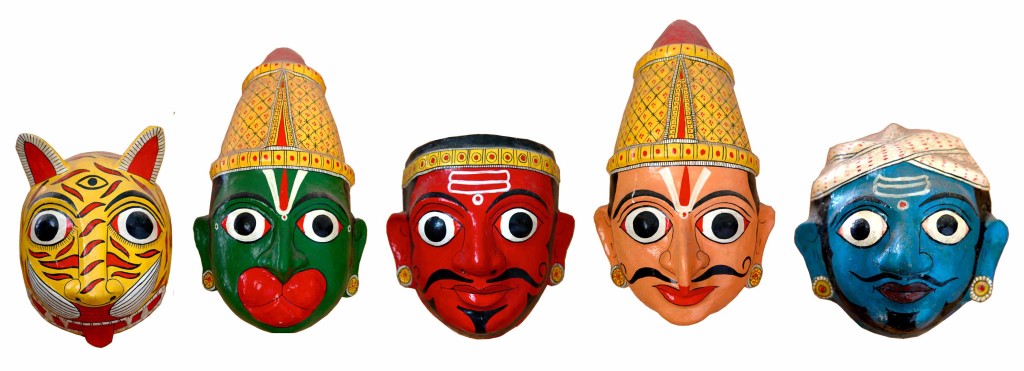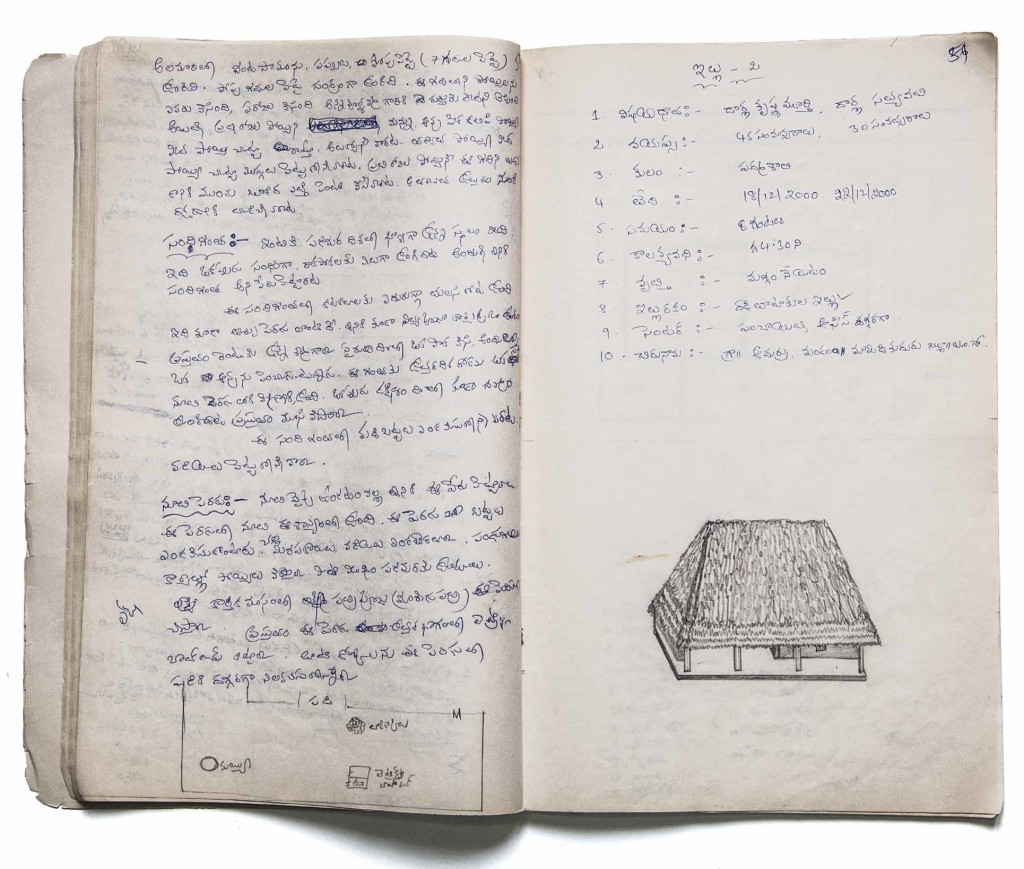– Shubhangi Singh
The Potti Sreeramulu Telugu University established its School of Folk and Tribal Lore in 1995. The school was founded with the intention of systematically classifying indigenous folk art and culture existing within the Telugu diaspora. There were two major driving forces for this intention – firstly, the then Chief Minister N.T. Rama Rao and his cultural collaborators felt the need to collect, organise and revive artistic and cultural forms emblematic of Telugu people; secondly, there existed a statist impulse to archive forms that pre-existed the burgeoning migration, urbanisation and apparent drain of rural culture.
Amongst four new departments of the university, the School of Folk and Tribal Lore established itself in Warangal due to its proximity to indigenous and scheduled caste populations around the district. The focus of this department has been research and mutlifaceted documentation of folklore in the Telangana and Andhra Pradesh region, preserving this research and documentation by way of an archive and a museum as well as publishing material on the basis of their holdings. The school also initiates and participates in outreach activities such as the State and Regional Folk Festival it organised in Warangal in 1997 that witnessed the participation of around four hundred folk artists and performers.
 According to Professor Bhattu Ramesh, the current dean of the School of Folk and Tribal Lore, “Before the folk festival of 1997 and the department’s involvement in the tribal community, there was a stigma attached to the work of these folk artists and performers of the community. There was little dignity to their craft, driving them to very bottom of the social ladder. The folk artists within many indigeneous communtities like the Chindu, Kunapulli and Padmashalis were often referred to as ‘beggars’ amongst their parent and dependent communities.” “Through the school’s study of their practices”, Ramesh adds “there is a new respect associated with folk art and the manner in which the folk artists were addressed had undergone a significant change. Statements like “where are those beggars” used commonly by people looking for the performers have notably altered to “where are those (name specific) Chindu performers” or “where can we find the Jangam-storytellers”.
According to Professor Bhattu Ramesh, the current dean of the School of Folk and Tribal Lore, “Before the folk festival of 1997 and the department’s involvement in the tribal community, there was a stigma attached to the work of these folk artists and performers of the community. There was little dignity to their craft, driving them to very bottom of the social ladder. The folk artists within many indigeneous communtities like the Chindu, Kunapulli and Padmashalis were often referred to as ‘beggars’ amongst their parent and dependent communities.” “Through the school’s study of their practices”, Ramesh adds “there is a new respect associated with folk art and the manner in which the folk artists were addressed had undergone a significant change. Statements like “where are those beggars” used commonly by people looking for the performers have notably altered to “where are those (name specific) Chindu performers” or “where can we find the Jangam-storytellers”.
While the words of the archivist seem to carry the academic weight of university truths, it would be useful to probe the extent to which these perspectives behind them express a specific point of view. Gogu Shyamala, a Telugu language writer and women’s activist who belongs to the Madiga community, diverges from Professor Ramesh’s notions of institution driven diginity for the folk artsists. She believes that is incorrect to assume that these folk artists did not take pride in their art before the involvement of the department. Shyamala states that while the instances of some folks artists being referred to as “beggars” is not unheard of, it is largely, a misunderstanding stemming from lack of cultural context and is usually cited by people outside such communities. The occupation of the folks artists is well acknowledged within their own and connected communites. “It is a common practice within most folks artists of the tribal or sub-caste community, like the performers from Chindu community for example, to have the right to demand food or a night’s shelter from their master community in exchange for their performance”, Shyamala explains. “ At times, it does not need to even be in exchange of a performance. Through their art, the folk artists are believed to be keepers of history that contains stories of the caste origins (Jambavapuranam or the genesis) that links together all the related communities and castes that fall within the realm of the story-teller’s community. This role puts the artists at an important position within the cultural scheme of the communities making them legitimate beneficiaries of the demands for food made by the artists. This exchange is often misunderstood as alms, hence, earning these folk artists the reputation of being beggars. The occupation of the folks artists is well acknowledged within their own and that of their connected communites” Shyamala clarifies.
Archives serve as an important source of original material that record and narrate our collective historical voice. Given this role, it is important to understand what influences  an archive’s collection and how the items, both present and absent, impact our consciousness of an event or time period. Archives do not always comprise the most accurate, complete picture of any particular time or event. Items are carefully selected by archivists who are bound by their institution’s collection/development policies, the mission of their organisation and the availability of materials at the time of recording. As evident from the divergent viewpoints expressed between Bhattu Ramesh and Gogu Shyamala, they are also deeply driven by their own cultural position and understanding of the field. The dominant narrative stored in the archives is thus inescapably influenced by institutions or individuals collating the information. How then, can these material found in the archives be treated as the truth?
an archive’s collection and how the items, both present and absent, impact our consciousness of an event or time period. Archives do not always comprise the most accurate, complete picture of any particular time or event. Items are carefully selected by archivists who are bound by their institution’s collection/development policies, the mission of their organisation and the availability of materials at the time of recording. As evident from the divergent viewpoints expressed between Bhattu Ramesh and Gogu Shyamala, they are also deeply driven by their own cultural position and understanding of the field. The dominant narrative stored in the archives is thus inescapably influenced by institutions or individuals collating the information. How then, can these material found in the archives be treated as the truth?
The answer is that it cannot. Those studying the material can only consider it a guide, a particular representation of history that could instigate curiosity to dig deeper in a realm of interest. On the one hand, the act of research holds the potential to further amalgamate narratives missing from archives or popular discourse. On the other, purposeful examination of the archiving policy and the politics of the community whose cultural artefacts are being collected would provide the researcher an insight into the politics at play between the intention of the archive and the culture being archived.
Archivists, whether during the process of collection or conservation, always face an ethical dilemma. How does one represent people, their art and their culture through the act of conservation? This question is at the forefront of debates around conservation. Art historian Jital Gandhy has raised questions pertaining to the authenticity of the archivist by critiquing the gaze of the data collector. He states that during the process of collecting data for archiving, a common error is introduced by the fact that “as outsiders to a culture, in addition to documenting what they observe, they subconsciously inlay records with their own personal or altruistic experience. This inlay can seep through the porous material that is collected for the purpose of preservation”. Activists and scholars continuously discuss factors that influence the authenticity of collected data. The questions such discussion raise include: Who is the informant? Who is the data collector? What issues of access exist in the process? What is archived? Why and for whom? What does it mean to ‘look into’ the lives of others as opposed to ‘looking within’ ones own community?
Arjun Appadurai (1988) examines the term ‘native’ with a focus on authenticity, “proper natives are somehow assumed to represent their selves and their history, without distortion or residue”. Those in the position to observe ‘natives,’ however, exempt themselves from being authentic and instead represent themselves in terms of complexity, diversity and ambiguity. Anthropologist Kirin Narayan further elaborates on Appadurai’s critique of the term native, extending the term to ‘native anthropologist’. A ‘native’ is assumed to be an insider who will forward an authentic point of view to the anthropological community. It is clear that the profession remains intrigued by the notion of the ‘native anthropologist’ which somehow bears an assumed stamp of authenticity. Narayan argues that this is particularly obvious in the ways in which identities are doled out to non-Western, minority, or mixed race anthropologists so that exotic difference overshadows commonalities or complexities. This politics of the ‘insider/outsider’ plays an important part in the process of data collection, allowing a more effective questioning of authenticity and authority of archives.
In the case of the School of Folk and Tribal Lore, the insider/outsider politics shows itself in some complexity. Being Telugu speakers from the same region as those who they document and study, researchers in the school can claim a degree of authenticity that did not exist in previous generations of ethnographers, namely those who operated by way of colonial rule. The cultural familiarity between the subjects and the researchers helps the latter navigate within the community where the researchers are expected to represent the identity of the community and its practices in a manner closest to authentic. Despite belonging to a larger shared cultural background, the field researchers still, often, fall on the outside due to the difference in total community acceptance or access which would be responsible in influencing their perceptions and statistics leading to misconstrued data. There is, in addition, the dimension of power in the relationship between the researcher’s community and the subject’s, in this case due to the caste hierarchy. The interpreted documentation, thus often, creates a gap between the truth and the translation of that truth into data that ultimately creates the archives.
Questioning archival intent, institutional or otherwise, is to problematize the act of conservation and, thus, to understand it better. Since so many above-discussed factors determine what ultimately sits on the shelves, in the computers for the future to access as ‘truth’, it is imperative to doubt its authenticity and question the influences on the source material. In the case of institutional conservation practices involving indigenous culture, as in the case of Potti Sreeramulu Telugu University’s School of Folk and Tribal Lore, questioning who is speaking for whom, why and in what manner could serve as the next steps forward in the complex politics of archival practice.
Shubhangi Singh is an independent filmmaker and visual artist
singh.shubhangisingh@gmail.com![]()

